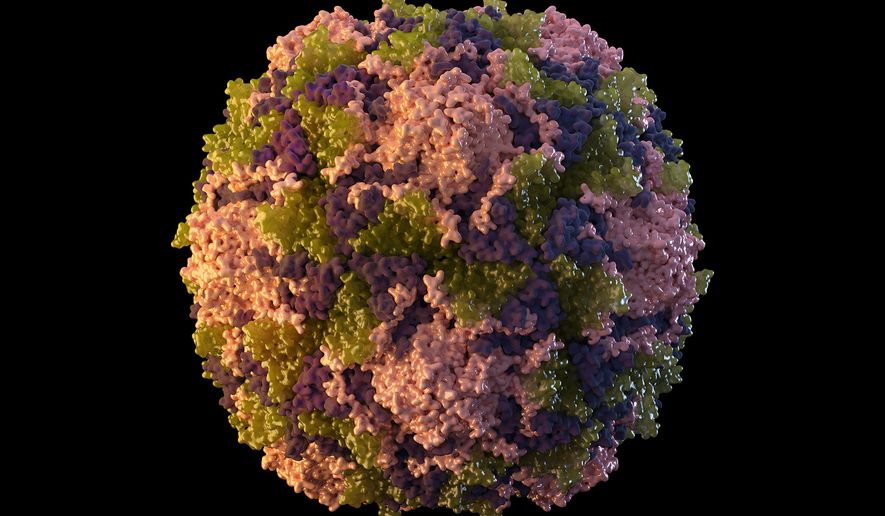Health officials have detected polio in the wastewater in New York City, a development that portends community spread of the virus in a densely populated part of America that has suffered greatly from COVID-19 and is the epicenter of the monkeypox outbreak.
State and city health officials said sewage samples sent to the Centers for Disease Control and Prevention confirmed the presence of the virus, which can cause paralysis and death.
Health departments identified one case of vaccine-derived poliovirus in Rockland County, New York, last month, but the samples suggest the virus could be pinging around the Big Apple, too.
Officials said they are working aggressively to assess the extent of the spread. They fear the pathogen will afflict people who are unvaccinated or not up to date on their vaccines.
“For every one case of paralytic polio identified, hundreds more may be undetected,” said state Health Commissioner Mary T. Bassett. “The detection of poliovirus in wastewater samples in New York City is alarming but not surprising.”
City Health and Mental Hygiene Commissioner Ashwin Vasan said polio poses a real risk to New Yorkers but “the defense is so simple.”
“With polio circulating in our communities, there is simply nothing more essential than vaccinating our children to protect them from this virus, and if you’re an unvaccinated or incompletely vaccinated adult, please choose now to get the vaccine,” he said. “Polio is entirely preventable, and its reappearance should be a call to action for all of us.”
Polio, a highly contagious disease, was devastating in the early 20th century before a vaccine was discovered. A wild type of the virus is endemic to Afghanistan and Pakistan, though it has been detected in Mozambique this year.
The CDC said the case in New York was a vaccine-derived poliovirus, or VDPV, in an unvaccinated person.
The VDPV strain is related to the weakened live poliovirus in the Sabin vaccine, also known as the oral polio vaccine (OPV). In rare instances, it can prey on undervaccinated or immunodeficient populations and revert to a form that causes illness.
The OPV is no longer licensed in the U.S. but is used in other parts of the world.
The U.S. has been giving children the inactivated poliovirus vaccine (IPV) since 2000.
Children typically get a course of four polio vaccines from ages 2 months to 6 years.
Some groups, including some in the Orthodox Jewish community in Rockland County, have resisted vaccination, sparking calls for an information campaign. The same communities struggled with a measles outbreak in 2018 and 2019 that was blamed on poor vaccination rates.
Officials said vaccination rates are lagging in parts of the city. About 86% of city children ages 6 months to 5 years have received three doses, meaning 14% are not up to date. Neighborhoods in Brooklyn have vaccination rates below 70%.
“The reintroduction of polio is just really bad news,” said Arthur Caplan, director of the division of medical ethics at the New York University Grossman School of Medicine.
He expressed concern that the anti-vaccine community might seize on the case as a “vaccine-derived” polio virus and gloss over the fact that the OPV vaccine is no longer used in the U.S. Getting the currently available vaccine is the best defense, he said.
Some people who contract polio don’t feel any symptoms, prompting increased worry about the silent spread of the virus. New York City is particularly vulnerable to the spread of infectious diseases because of the close contact among people, especially on mass transit systems.
Folks in Los Angeles tend to rely on cars for transportation.
New York is also a major hub for tourists and visitors, so pathogens can be introduced easily.
The city is already struggling to contain a monkeypox outbreak. Although the disease is rarely fatal, it causes painful rashes and lesions. New York state accounts for about one-fifth of the 10,700-plus monkeypox cases recorded in the U.S. Several countries are battling the disease outside Africa, where the virus is endemic.
New York City was also the epicenter of COVID-19 during the first months of the pandemic in 2020. The eerie sound of ambulances filled city streets, and hospitals were forced to create makeshift morgues.
“We have to pivot and shift in the face of the crises as they come towards us. We did it with COVID, monkeypox and everything else that we have been facing,” New York Mayor Eric Adams, a Democrat, told Fox 5 “Good Day New York” on Friday in a broader discussion about a shelter shortage.
Officials warned that polio can cause permanent paralysis of the arms and legs and might be fatal because of paralysis in muscles used to breathe or swallow.
They said most people infected with the virus do not have any symptoms, though some feel flulike symptoms such as sore throat, fever, fatigue, nausea and stomach pain.
Beyond New York, officials in London have detected the polio virus in wastewater, adding to the alarm of the discovery.
Disease fighters are considering various steps to fight a potential outbreak, including extra doses for people who aren’t up to date on vaccination. British officials started offering boosters in the London area.
• Tom Howell Jr. can be reached at thowell@washingtontimes.com.




Please read our comment policy before commenting.